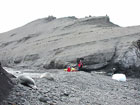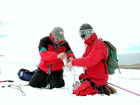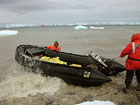12/13/01
near 65 15 south
59 30 west
7.5 degrees C a heat wave!!
Light winds
Robertson Island at the eastern edge of the Seal Nunataks provides the setting for today's work. Around 10 a.m. this morning Eugene Domack, Bob Gilbert and I went ashore at Cape Marsh on Robertson Island. The purpose of our trip was to collect snow samples at various points up the island's snow-covered dome which will be melted and filtered in the lab to study wind blown dust particles that accumulate in the snow. Hopes are to find not only locally derived particles from the Seal Nunataks, but also material from the Antarctic Peninsula itself. An added bonus is that where we landed is an exposure of Upper Cretaceous fossiliferous marine sediments which are only exposed on this point.
Following a relatively easy landing by zodiac raft we climbed over the exposed outcrops and then upward onto the snow slopes. With a turn around time of 2 p.m., we sampled snow at various points on our upward climb, marking the locations on our handheld GPS units. Snow samples were left at the sample sites for collection on the way down. At 2 p.m. we reached our high point on the dome, which was no where near the top by any means. Scale is a very difficult thing to judge here. On our descent our packs became heavier as the snow was loaded in and we reached our landing site on shore well ahead of our scheduled pick up time of 4 p.m. A good thing too, as the tide had come in and our landing beach was rapidly disappearing. Even the Weddell seals basking on the beach had moved upslope. A zodiac was sent from the ship and the zodiac crew made our pick up look easy. These people are the best in the business and their support makes this kind of science possible.
Enjoy some photos from today. I'm off to bed.
Cheers,
Dave

The landing at Cape Marsh, Robertson Island Antarctica. Upper Cretaceous fossiliferous marine sediments outcrop at this one point on the island. (Click image for larger version.)

Bob Gilbert and Eugene Domack collecting snow samples. Measured volumes of snow are sampled and bagged for return to the lab. In the lab snow is melted and melt is filtered. Microscopic analysis of particulates on the filter paper may provide information where the particles were derived from. (Click image for larger version.)

Tabular iceberg in the shallows around Robertson Island as viewed from the zodiac as we approached the beach. (Click image for larger version.)

Zodiac crewmen position the boat for transport of the shore party back to the Palmer. Full immersion suits protect the crewman from the subfreezing water. Note the Palmer in the distance behind the two icebergs in the center of the view. The ship is 308 feet long to give you a sense of scale. Thanks for picking us up guys! (Click image for larger version.)





